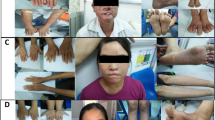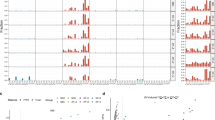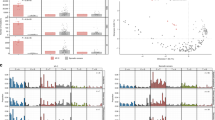Abstract
XERODERMA pigmentosum (XP) is an inherited human disease characterised by the development of pigmentation abnormalities and numerous malignancies on sun-exposed areas1. Fibroblasts from typical patients with XP are defective in the repair of ultraviolet-produced damage of their DNA: These cells show (with respect to normal fibroblasts) decreased amounts of ultraviolet-induced unscheduled DNA synthesis1–3, less ultraviolet-induced uptake of bromodeoxyuridine into parental DNA (refs 2 and 4), and greater sensitivity to ultraviolet irradiation in terms of colony forming ability5–7. The relationship of the DNA repair defect(s) to the clinical manifestations of XP, however, has been obscured by the finding of a group of patients, designated XP ‘variants’8, who have the clinical manifestations of the disease1,8, but whose cells lack the repair defects (Table 1). Using a sensitive host-cell reactivation technique, I have found that fibroblasts from patients belonging to all five known variant kindreds have defects in the repair of DNA damaged by ultraviolet irradiation.
This is a preview of subscription content, access via your institution
Access options
Subscribe to this journal
Receive 51 print issues and online access
$199.00 per year
only $3.90 per issue
Buy this article
- Purchase on Springer Link
- Instant access to full article PDF
Prices may be subject to local taxes which are calculated during checkout
Similar content being viewed by others
References
Robbins, J. H., Kraemer, K. H., Lutzner, M. A., Festoff, B. W., and Coon, H. G., Ann. intern Med., 80, 221–248 (1974).
Cleaver, J., Nature, 218, 652–656 (1968).
Burk, P. G., Yuspa, S. H., Lutzner, M. A., and Robbins, J. H., Lancet, i, 601 (1971).
Regan, J. D., Setlow, R. B., and Ley, R. D., Proc. natn. Acad. Sci. U.S.A., 68, 708–712 (1971).
Cleaver, J. E., Int. J. rad. Biol., 18, 557–565 (1970).
Kraemer, K. H., Barrett, S. F., and Robbins, J. H., Clinical Res. (in the press)
Takebe, H., Furuyama, J.-I., Miki, Y., and Kondo, S., Mutation Res., 15, 98–100 (1972).
Cleaver, J., J. Invest. Dermatol., 58, 124–128 (1972).
Day, R. S., Cancer Res., 34, 1965–1979 (1974).
Day, R. S., Photochem. Photobiol., 19, 9–13 (1974).
Lehmann, A. R., et al. Proc. natn. Acad. Sci. U.S.A. (in the press).
Lehmann, A. R., Life Sci. (in the press).
Kleijer, W. J., de-Weerd-Kastelein, E. A., Sluyter, M. L., Keijzer, W., deWit, J., and Bootsma, D., Mutation Res., 20, 417–428 (1974).
Author information
Authors and Affiliations
Rights and permissions
About this article
Cite this article
DAY, R. Xeroderma pigmentosum variants have decreased repair of ultraviolet-damaged DNA. Nature 253, 748–749 (1975). https://doi.org/10.1038/253748a0
Received:
Published:
Issue Date:
DOI: https://doi.org/10.1038/253748a0
This article is cited by
-
Roberts syndrome fibroblasts showing cisplatin hypersensitivity have normal host cell reactivation of cisplatin-treated adenovirus and normal capacity of cisplatin-treated cells for adenovirus DNA synthesis
Somatic Cell and Molecular Genetics (1996)
-
Repair deficient human disorders and cancer
Nature (1978)
-
Neoplastic transformation induced by a direct perturbation of DNA
Nature (1978)
Comments
By submitting a comment you agree to abide by our Terms and Community Guidelines. If you find something abusive or that does not comply with our terms or guidelines please flag it as inappropriate.



